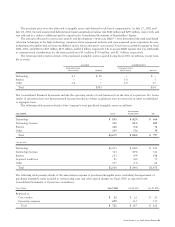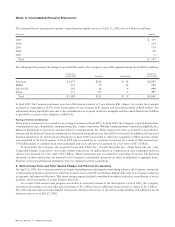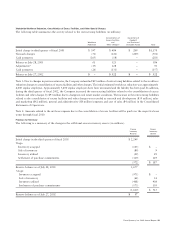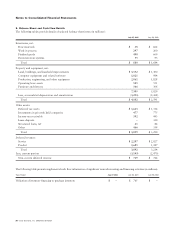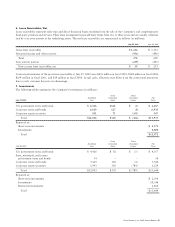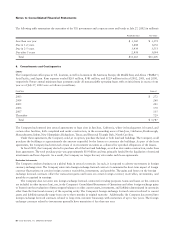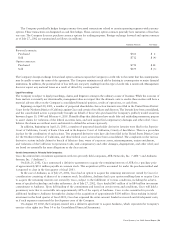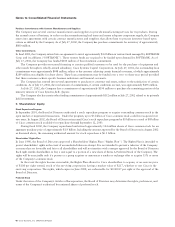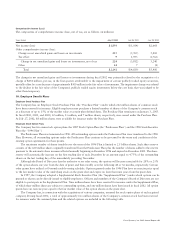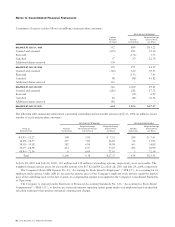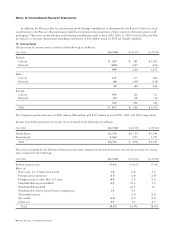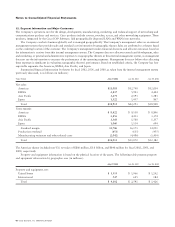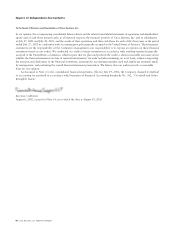Cisco 2002 Annual Report Download - page 45
Download and view the complete annual report
Please find page 45 of the 2002 Cisco annual report below. You can navigate through the pages in the report by either clicking on the pages listed below, or by using the keyword search tool below to find specific information within the annual report.
Cisco Systems, Inc. 2002 Annual Report 43
Pro forma information under SFAS 123 is as follows (in millions, except per-share amounts):
Years Ended July 27, 2002 July 28, 2001 July 29, 2000
Net income (loss)—as reported $ 1,893 $ (1,014) $ 2,668
Stock option compensation expense, net of tax (1,520) (1,691) (1,119)
Net income (loss)—pro forma $ 373 $ (2,705) $ 1,549
Basic net income (loss) per share—as reported $ 0.26 $ (0.14) $ 0.39
Diluted net income (loss) per share—as reported $ 0.25 $ (0.14) $ 0.36
Basic net income (loss) per share—pro forma $ 0.05 $ (0.38) $ 0.22
Diluted net income (loss) per share—pro forma $ 0.05 $ (0.38) $ 0.21
The value of each option grant is estimated on the date of grant using the Black-Scholes option pricing model with the follow-
ing weighted-average assumptions:
EMPLOYEE STOCK OPTION PLANS EMPLOYEE STOCK PURCHASE PLAN
July 27, 2002 July 28, 2001 July 29, 2000 July 27, 2002 July 28, 2001 July 29, 2000
Expected dividend 0.0% 0.0% 0.0% 0.0% 0.0% 0.0%
Risk-free interest rate 4.7% 5.4% 6.4% 3.1% 5.3% 5.3%
Expected volatility 47.5% 34.8% 33.9% 58.1% 35.0% 43.3%
Expected life (in years) 5.5 3.6 3.1 0.5 0.5 0.5
The Black-Scholes option pricing model was developed for use in estimating the value of traded options that have no vesting
restrictions and are fully transferable. In addition, option pricing models require the input of highly subjective assumptions
including the expected stock price volatility. The Company uses projected data for expected volatility and expected life of its stock
options based upon historical and other economic data trended into future years. Because the Company’s employee stock options
have characteristics significantly different from those of traded options, and because changes in the subjective input assumptions
can materially affect the estimate, in management’s opinion, the existing models do not provide a reliable single measure of the
fair value of the Company’s options. Under the Black-Scholes option pricing model, the weighted-average estimated values of
employee stock options granted during fiscal 2002, 2001, and 2000 were $8.60, $13.31, and $19.44 per share, respectively.
Basic and diluted shares outstanding for the year ended July 27, 2002 were 7.3 billion and 7.4 billion shares, respectively.
Diluted shares outstanding include the dilutive impact of in-the-money options which is calculated based on the average share
price for each fiscal year using the treasury stock method. Under the treasury stock method, the tax-effected proceeds that would
be hypothetically received from the exercise of all in-the-money options are assumed to be used to repurchase shares. In fiscal 2002,
the dilutive impact of in-the-money employee stock options was approximately 130 million shares or approximately 2% of the
average shares outstanding based on Cisco’s average share price of $16.68. The Cisco share price at the end of fiscal 2002 was
$11.82; the dilutive impact of in-the-money stock options would be 80 million shares or approximately 1% of the average shares
outstanding in fiscal 2002.
Employee 401(k) Plans
The Company sponsors the Cisco Systems, Inc. 401(k) Plan (the “Plan”) to provide retirement benefits for its employees. As allowed
under Section 401(k) of the Internal Revenue Code, the Plan provides tax-deferred salary deductions for eligible employees. The
Company also has other 401(k) plans that it sponsors. These plans arose from acquisitions of other companies and are not material
to the Company on either an individual or aggregate basis.
Through December 31, 2001, employees could contribute from 1% to 15% of their annual compensation to the Plan. Effective
January 1, 2002, the employee contribution limit was increased to 25% of their annual compensation. Employee contributions are
limited to a maximum annual amount as set periodically by the Internal Revenue Service. The Company matches employee contributions
dollar for dollar up to a maximum of $1,500 per year per person. All matching contributions vest immediately. The Company’s
matching contributions to the Plan totaled $35 million, $45 million, and $34 million in fiscal 2002, 2001, and 2000, respectively.
Effective January 1, 2003, the new matching structure will be 50% of the first 6% of eligible earnings that are contributed by employees.
Therefore, the maximum matching contribution that the Company may allocate to each participant’s account will not exceed
$6,000 for the 2003 calendar year due to the $200,000 annual limit on eligible earnings imposed by the Internal Revenue Service.


